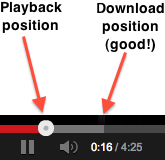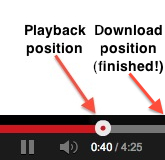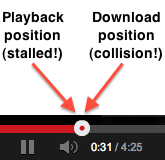| | Practical Computer Advice
from Martin Kadansky
| | | Volume 7 Issue 3 | March 2013 |
| | | | Why Do YouTube Videos (or Other Streaming Content) "Stall" During Playback?The Problem Does this ever happen to you? - You click on a YouTube video, movie, television show, Ted.com talk, music clip, seminar, or some other "streaming" audio or video content on the internet.
- It starts to play, but soon it stalls or pauses.
- It may play a little more, but then it pauses again, and repeats this cycle over and over, like it's struggling to play.
- Some of the time it may "recover" and resume playing to the end, but other times you may see that it's "buffering," or it may stop completely.
What should you do when this happens? This is a common problem with "streaming media," i.e., audio or video that you're listening to or watching "live" as it downloads from the internet, as opposed to content that you first download in its entirety and save on your computer, and then play back from your hard drive. The reason for this problem The core issue here is the difference between "download speed" and "playback speed." When you play music or video that's already on your computer, unless your computer is busy doing too many other things, your hard drive can easily supply the raw data quickly enough so that it plays seamlessly and with no interruptions. However, when your computer is playing streaming content straight off the internet, the download speed might be slower than the playback speed, which means that the playback may "catch up" to the download and have to pause until more content is downloaded. Here's an analogy: Imagine you're reading from a teleprompter and giving a speech that you haven't memorized in advance. If the supply of words and sentences on the prompter is steady and plentiful, then there will be no interruption in the presentation (except when you breathe). However, if the supply of words and sentences pauses, then you'll have to stop and wait until more appear. How can I tell that playback has stalled? On YouTube.com (as well as most other streaming media sites) there are four important elements on each playback controller:    - The red area indicates the portion of the video you've already downloaded and watched.
- The spot where the red area ends (where you may also see a white circle) is your current playback position, and will move to the right.
- The light grey area indicates the portion of the video that your computer is downloading and that you haven't watched yet. If the light grey area moves faster than the red area, then playback should be fine.
- The dark grey area represents the rest of the video that has not yet been downloaded. If the dark grey has been overrun by the light grey, then the download has finished (which is good!), so the playback should go smoothly.
- However, if the playback (red) catches up with the download, then the video will "stall" until more content is downloaded (which can be frustrating!).
Other playback systems may use different colors, but most have similar elements. What can you do when playback stalls? There are a number of things you can try when this happens. Easy to do: - Click the "Pause" button (the "pair of vertical bars") and wait for enough content to download to get a good "head start" (or finish downloading completely). Then click the "Play" button (the "right-pointing triangle").
- The server supplying the content may be busy with requests from too many other users, or your ISP may be experiencing a temporary problem. Pause the playback, wait a few minutes, and try again.
- Reload (or Refresh) the web page to start over.
- If your playback controller permits it, try changing the video or audio stream to a lower quality setting. On YouTube, click the "gear" icon to get a menu of video quality choices.
- Delete your web browser's "cookies."
- Clear (delete) your web browser's "cache" or "temporary files."
- Close other web sites you may have open to free up some of your computer's resources.
- Close other programs you may have open.
Medium effort: - If you're using YouTube, go to Account Settings->Playback and try the option "I have a slow connection, never play higher-quality video."
- Note the web page you're on (or make a Favorite or Bookmark for it), close (or quit) your web browser, reopen it, return to that web page, and try playing the content again.
- Note the web page you're on, Restart your computer, return to that web page, and try again.
- Try disabling some of your browser's "ad-ons" or "plug-ins," especially ones that inspect content. "Adblock Plus" seems to be a common culprit.
- Try a different web browser. Sometimes alternate browsers like Chrome or Firefox work better than standard browsers like Internet Explorer or Safari.
More effort: - If your browser is running in 32-bit mode, try 64-bit mode if available (or vice-versa).
- If your streaming content uses Flash (this includes YouTube), try updating your Adobe Flash Player.
- If your computer is on a wireless connection, try plugging it in to a wired connection if available.
- Find the "hardware acceleration" options in your web browser, playback software (like Adobe Flash), and video hardware settings. If they're on, try turning each of them off.
- Get your computer checked for things that may be slowing it down: insufficient RAM, virus and spyware infections, unnecessary startup programs, fragmented hard drive, etc.
- A very slow or unstable internet connection can make streaming media unusable. If your computer frequently disconnects from your network or the internet, get that fixed.
Summary- Downloading content is always in a race against playback. If the download is faster, you'll get good playback. If the playback is faster and catches up to the download, you'll get poor playback.
- Since you usually can't adjust the playback speed (which might turn that action movie into a slow-moving epic, or make that bass singer sound like a chipmunk), focus on the things that affect the download speed: the server, your internet connection, and your computer.
- If the problem persists, there are many things you can try, but only you can decide how much time and effort it's worth to solve it.
Where to go from here- http://helpx.adobe.com/flash-player/kb/video-playback-issues.html: "Flash Player Help / Video playback issues"
- Learn more: Explore the functions on your playback controller, observe the symptoms of the problem and try to infer the source of the problem.
- If you can't resolve a streaming media problem, look for other ways you could get the same content, perhaps from a different web site, or by buying a CD or DVD, or by using a different computer or device.
- http://en.wikipedia.org/wiki/Streaming_media: History and technology of streaming media, including its earliest form: muzak
|
How to contact me: email: martin@kadansky.com phone: (617) 484-6657 web: http://www.kadansky.com On a regular basis I write about real issues faced by typical computer users. To subscribe to this newsletter, please send an email to martin@kadansky.com and I'll add you to the list, or visit http://www.kadansky.com/newsletter Did you miss a previous issue? You can find it in my newsletter archive: http://www.kadansky.com/newsletter Your privacy is important to me. I do not share my newsletter mailing list with anyone else, nor do I rent it out. Copyright (C) 2013 Kadansky Consulting, Inc. All rights reserved. I love helping people learn how to use their computers better! Like a "computer driving instructor," I work 1-on-1 with small business owners and individuals to help them find a more productive and successful relationship with their computers and other high-tech gadgets. |
| | | | | |
Return to the previous page Subscribe to this free newsletter Go to the Newsletter Archive | | | | | |
| | | | |